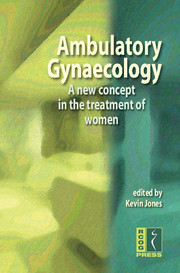Book contents
- Frontmatter
- Contents
- ABOUT THE AUTHORS
- ABBREVIATIONS
- PREFACE
- Chapter 1 Introduction
- Chapter 2 Anaesthesia and analgesia for outpatient gynaecology
- Chapter 3 Colposcopy services
- Chapter 4 Abnormal uterine bleeding
- Chapter 5 Endometrial ablation
- Chapter 6 Urogynaecology: urinary incontinence and genital prolapse
- Chapter 7 Infertility
- Chapter 8 Early pregnancy units and emergency gynaecological services
- Chapter 9 Pelvic utrasound and interventional radiology
- Index
Chapter 5 - Endometrial ablation
Published online by Cambridge University Press: 05 June 2014
- Frontmatter
- Contents
- ABOUT THE AUTHORS
- ABBREVIATIONS
- PREFACE
- Chapter 1 Introduction
- Chapter 2 Anaesthesia and analgesia for outpatient gynaecology
- Chapter 3 Colposcopy services
- Chapter 4 Abnormal uterine bleeding
- Chapter 5 Endometrial ablation
- Chapter 6 Urogynaecology: urinary incontinence and genital prolapse
- Chapter 7 Infertility
- Chapter 8 Early pregnancy units and emergency gynaecological services
- Chapter 9 Pelvic utrasound and interventional radiology
- Index
Summary
Introduction
In the previous chapter, we saw how the one-stop management philosophy can be applied to the investigation of women with menorrhagia. In this chapter, the conservative surgical treatment of this condition is described. The surgical treatment of women with menorrhagia who have no detectable pathology (i.e. women with dysfunctional uterine bleeding [DUB]) is called endometrial ablation. This is an office-based (outpatient) or daycase procedure, which destroys the lining of the uterus. The first-generation endometrial ablation techniques, such as transcervical electrosurgical resection or ablation, or the use of a neodymium:yttrium-aluminium-garnet laser, provided alternatives to hysterectomy and are carried out in the day surgery unit under spinal or general anaesthesia. These procedures are, however, being superseded by second-generation techniques, which require less technical skill to achieve uniform results and which are highly suitable for use in an outpatient gynaecology unit, in other words in the one-stop gynaecology setting.
Current methods of second-generation endometrial ablation
The use of second-generation devices generally involves destruction of the endometrium by heating or cooling. There are currently eight mechanisms and 12 instruments available. Only four of the devices, ThermaChoice® (Johnson & Johnson [corporation], New Brunswick, NJ, USA), Vesta™ (Valleylab, Boulder, CO, USA), MEA® (Microsulis, Denmead, UK) and Hydro ThermAblator® (Boston Scientific Limited, Christ Church, Barbados, Figure 5.1a-b), have been shown to be safe and effective in randomised clinical trials (RCTs) when compared with the first-generation techniques.
- Type
- Chapter
- Information
- Ambulatory GynaecologyA New Concept in the Treatment of Women, pp. 54 - 69Publisher: Cambridge University PressPrint publication year: 2008



